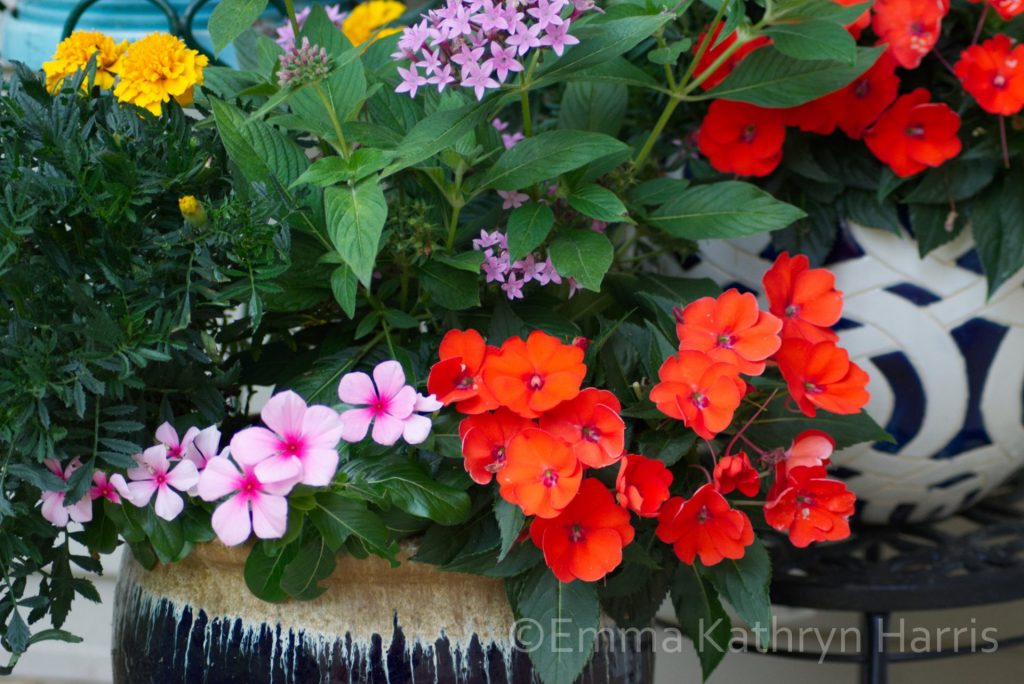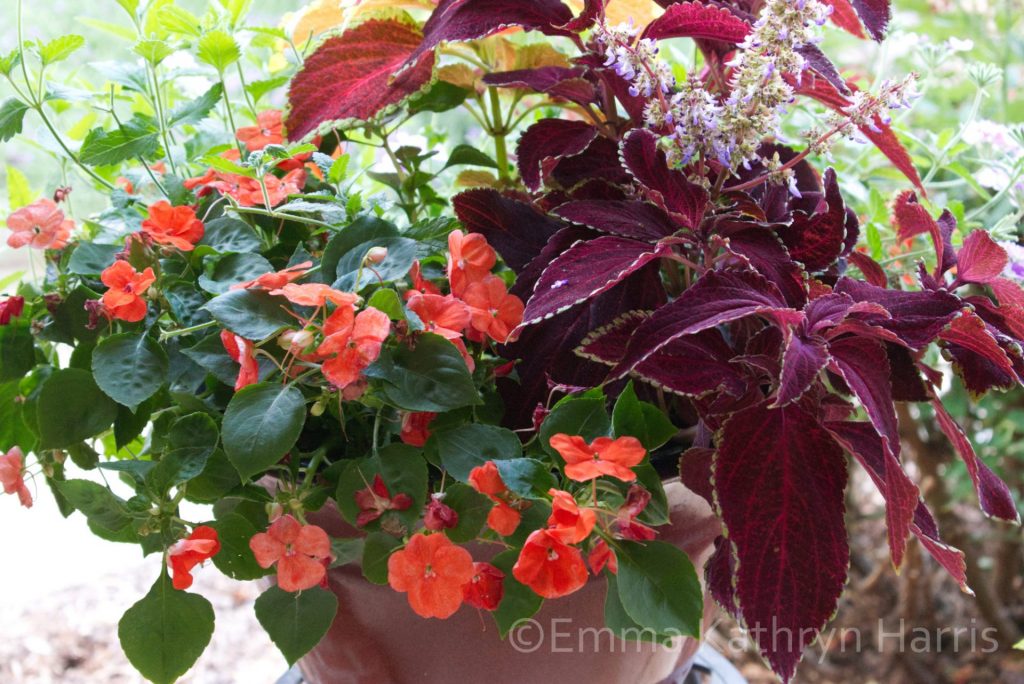Flowers always make people better, happier, and more helpful; they are sunshine, food and medicine for the soul.
Luther Burbank, Environmentalist
When referring to small space gardening, I often mean limited space because of living in an apartment, condominium, or in a dwelling that does not allow you to grow several square feet of flowers, vegetables and trees.
You might not have a yard. You are limited, instead, to a courtyard, balcony, a shared porch or none of these if you are in a high-rise building. And in some cases, your apartment or condominium does not have a lot of square footage, so you want to avoid crowding it with too much stuff.
For people who love plants, this can be a challenge. We might start with one or two plants, but over time, we could start to collect another one or two, and soon, our small space is crammed with plants.
This creates several challenges.
The challenge of crowding your small space with plants
First, the more you have in a small space, the smaller your space looks. An overabundance of stuff, including plants, gives the area a stifled and claustrophobic feel. Plants need to breathe, just as we do, and the oxygen should flow freely.
Second, a crowded space full of plants looks messy. Plant leaves turn brown or yellow, flower petals drop, plants die, become diseased or attract bugs (the latter two will also spread to the other plants). When you have that mixed in with the healthy leaves and plants, instead of being appealing, it looks appalling.
Third, the more plants you have, the more you have to maintain. If you are a busy person, all that watering, trimming, pruning, and replanting can eat into your precious time. So much so, you cannot even enjoy your plants. You grow tired and you simply let them fend for themselves, which never works well.
Fourth, your crowded space does not allow prominence for a feature plant. Having a plant that stands out, for whatever reason, draws in the eye. All the other plants around it should complement that plant. Whether the plant is somewhat large, has colorful foliage, a distinctive flower or something interesting, your plant should be the focal point. If you have too many plants, your plant space is a distraction and disengaging.
These are just a few reasons to reconsider crowding your small space.
So how can you, as a plant lover with a small space, enjoy plants without going overboard? How can you avoid making your space look dark, stuffy and unkempt with too much nature? Here are seven tips that might help you avoid crowding your small space.

1. Window boxes add character
Window boxes, to me, have always seemed to create character to a home. Coming home to flowers perched on a window or seeing them from the inside looking out, brings an atmosphere of comfort.
If you are in a position to have window boxes, these can be designed as little or as much as you desire. Some plants, such as geraniums, vincas, petunias and marigolds spread through the growing season, so your box will eventually look full if you decide just to plant one of these plants.
Others choose to add several plants and flowers to their boxes, depending on the size of the box. They might mix trailing flowers, such as alyssum and lantana with other flowers that tend to grow upward.
Having a theme in mind, such as English garden, can also help you plan out what you desire for a specific look.
Filling a window box with plants and flowers will draw the eye and look more than it really is, so consider this idea when trying to keep your space looking neat and appealing.

2. Containers allow for easier movement
If you have a balcony, small porch space, or patio, container gardening can be a key to enjoying plants. And containers are easier to move around if sunshine is an issue and/or your plants need to be replaced, or some grow taller than others and you need to readjust your design. Containers give us more freedom and creativity to play with plants.
You still need to exercise a bit of caution in going overboard with too many containers and too many plants. One plant looks great in one container and could even become your feature plant. And some plants are better not sharing the pot for a variety of reasons.
When using containers, stick to odd numbers. In other words, one pot, three pots, as opposed to two pots, four pots. Or, if you add in another feature, such as a bird feeder, bistro set, small fountain or some other object, that could be your third to your two pots. Again, avoid overcrowding with objects as well.
With container gardening, you are not necessarily going for the landscaped, manicured look, but you do want to keep things simple and neat.
Second, add dimensions. You could have a large, tall pot with a medium then small pot. Your flowers and plants will help with dimension. Place plants that grow tall in the back of your arrangement, and the smaller ones in the front.
You can help along the dimensions by using plant stands at various sizes as well.
3. Shelves can create a picture
What is cool about shelves is you do not have to have everything uniformly stacked. A plant on one shelf with a knickknack from your international trip, a piece of framed art, or something else you enjoy, creates an artistic image.
Adding a green plant, violet, or other plant to the design gives the room a calming effect. Again, do not feel you have to fill your shelves with plants. One or two will do for smaller shelves.
Make sure your shelves are steady lest you have a mess on your hands if one should come apart. Another reason not to stack them with too many plants. Water and soil are heavy!
Whether your shelves are inside or outdoors, again, pay attention to the lighting so your plants get what they need with the sunlight.
4. Lattices and fences create privacy
If you live in an apartment or other residence that lacks privacy from one balcony to the other, consider putting up a lattice. Lattices are excellent for climbing vines, such as morning glories and clematis, which will fill the lattice and create a natural privacy screen.
As well, if you have some type of fence or similar barrier, climbing vines enjoy this setting too. If your fence is sturdy, this can also be convenient for a window box or hanging plant.
Lattices and fences allow you to grow climbing plants that will give you just enough foliage without crowding your space with containers.
5. Hanging baskets add dimension
Hanging baskets can be a nice addition to a fence (as mentioned), at your doorway (to the side of course), or even in your home if floor and shelf space are not options. In the home, you can hang them from the ceiling, preferably close to a corner to avoid hitting it; if you have cathedral ceilings, you could hang a longer basket as this will draw the eye downward.
Plants that cascade, such as a spider plant or begonia, create length and dimension to an otherwise smaller basket. Unlike a window box which needs a window sill or fence to latch onto, hanging plants can be hung just about anywhere and create a little garden from above.
6. Spread out
If you have multiple plants, you are not restricted to put them all in one spot, nor should you. Again, you are trying to avoid crowding your small space, and putting all your plants together will defeat your purpose.
Using the above suggestions, you can easily spread out your plants throughout your home and on your balcony or porch. Your goal should be to create a simple, aesthetically pleasing look. And plants should have a calming effect, which they do when they are discreetly placed in a variety of areas.

7. Planning and mapping save you space
The best way to avoid crowding your space is to plan and map your arrangements. If you do not already have plants, this is an ideal time to make a list of what you what. Then, put your empty containers in your space to see what possibilities you have. Before buying your plants, know how tall and wide they will grow as this will affect your arrangement.
If you already have plants, try playing with your space and moving them around to see what works well in various spaces and environments. Understand that overall, plants do not often like to be moved as they thrive in a familiar environment, so keep the movement to a minimum. However, if they have been crowded for some time, moving them to a space where they can breathe and even get more light might be beneficial for their growth.
Keep in mind placement of your plants—are they in full sun or full shade? If you live in the city, the harsh lights, such as security lights, will confuse the plants into thinking it is daylight, which will affect their growth.
As well, reflection from buildings and white walls will bounce sunlight onto your plants, which could damage some of them.
With so many possibilities to be creative with our plant placement, even small spaces can still look vast and peaceful with nature around us.


